Paul Gilster's Blog, page 78
September 26, 2019
Looking Back, and Ahead
Centauri Dreams was launched as a website in 2004 for a specific reason. I was wrapping up my book of the same name and wanted to build a simple database of news stories related to the angles on interstellar flight I had covered in the book. I intended the site to be used for no other purpose, and didn’t turn on the comments function until a year after the site went live. My plans were for a second edition of the book, but I began to realize as the website grew that to avoid instant obsolescence, the Web was my best friend. This site, then, began serving as a de facto second edition and I’ve kept it running now for 15 years.
Sometimes I’m asked how long I plan to keep the site going, and the answer is simply that I plan to be here for years to come. I have no thoughts about closing down Centauri Dreams. But as my work in the space community has grown, I’ve also become involved in various other aerospace efforts to which I’ve contributed, and right now I’m in the midst of a report on a particular kind of interstellar mission that demands a lot of transcription of talks, extensive note-taking along the way, and drawing together a lot of different viewpoints and research.
In practical terms, while Centauri Dreams isn’t going away, this also means that my posts are occasionally going to become sporadic, as they will be in the next few weeks. I’ll post when I can, but I have to devote the bulk of my attention to this particular project, which leaves little time for anything else in my workday. So bear with me, please. The comments are still live and I’ll do moderation on them at least twice a day. Feel free to comment when you have the urge. Once I get the current effort wrapped up, things should return to something like normalcy.






September 24, 2019
2I/Borisov: Naming the Interstellar Visitor
Congratulations to Gennady Borisov, the Crimean amateur who discovered the object now officially designated as 2I/Borisov (with a 0.65-metre telescope he built himself!). That ‘I’ in the designation points to the object’s interstellar origins, and picks up the nomenclature used with the first interstellar object in our system, 1I/‘Oumuamua. We’ve examined thousands of comets over the years but have found none with an orbit as hyperbolic as 2I/Borisov. That means that while the comet’s trajectory is being affected by the Sun, it’s not going to be captured by it.
What’s ahead: 2I/Borisov reaches perihelion on 7 December 2019, at which point it will be 2 astronomical units from the Sun and also 2 AU from Earth. It reaches its brightest levels in the southern sky in December and January and then heads back out toward the interstellar deep. So far, it appears that 2I/Borisov is a few kilometers in diameter, and we’ve also learned — via the Gran Telescopio Canarias (Canary Islands) — that its spectrum resembles typical cometary nuclei. The new interstellar visitor appears to be more straightforward than 1I/‘Oumuamua.
But considering that 1I/‘Oumuamua appeared a scant two years before 2I/Borisov, the inference is clear that such objects may be fairly numerous. Keep in mind that new instrumentation about to come online will expand our catalog, allowing us to investigate exoplanetary systems in ways beyond radial velocity and transits, through the spectra of objects within our own system.

Image: A comet from beyond our Solar System, as imaged by the Gemini Observatory. The image of the newly discovered object, named 2I/Borisov, was obtained on the night of 9–10 September 2019 using the Gemini Multi-Object Spectrograph on the Gemini North Telescope on Hawaii’s Mauna Kea. Credit: Gemini Observatory/NSF/AURA.
There is little doubt about 2I/Borisov’s cometary nature, given that observations have shown a condensed coma and a short tail. The IAU’s decision to give it a designation as an interstellar object follows the computation of its orbit by the IAU Minor Planet Center, with confirmation of the hyperbolic orbit from JPL’s Solar System Dynamics Group. Now we wait to learn how often to expect such objects and how much information we will be able to tease out of them.






September 20, 2019
Marc Millis: Testing Possible Spacedrives
Marc Millis, former head of NASA’s Breakthrough Propulsion Physics project, recently returned from another trip to Germany, where he worked with Martin Tajmar’s SpaceDrive project at Germany’s Technische Universität Dresden. Recent coverage of the ongoing experimental work into spacedrives in both the popular and scientific press has raised public interest, leading Millis to explain in today’s essay why and how the techniques for studying these matters are improving, and how far we have to go before we have something definitive. Millis is in the midst of developing an interstellar propulsion study from a NASA grant even as he continues to examine advanced propulsion concepts and the methodologies with which to approach them.
by Marc Millis

Two recent articles, one in Scientific American [1] and the other in Acta Astronautica [2], prompted this update about the experimental tests of possible spacedrives. In short, the experimental methods are improving, but definitive results are not yet in hand. While this update is mostly on the “Mach Effect Thruster,” it also touches on the infamous “EmDrive,” as well as a refresher on the general quest for spacedrive physics.
First, what is a spacedrive? Presently, a spacedrive is still a goal rather than a proven device. The ambition is to find a fundamentally different way to propel spacecraft rather than rockets or sails. Rockets are limited by having to carry their entire journey’s reaction mass with them (propellant). Sails are limited by one-directional photons (or particles) from an external source. Imagine, instead, if there was some way for a spacecraft to interact with its surrounding spacetime to move in any direction and be limited only by the amount of available energy. That ambition is the essence of a spacedrive.
That detail – of interacting with spacetime to induce motion – is a matter of undiscovered physics. That makes it harder to grasp, harder to explain, and harder to solve. It’s easier to grasp engineering challenges that are based on known physics, since there are already operating principles to cite. With spacedrives, the operating principles are works-in-progress – more akin to lines of inquiry than having complete packages ready for scrutiny. Though theories for faster-than-light warp drives do exist (one type of spacedrive), the physics of the required negative energy is still debated – which itself is a prerequisite to devising how to engineer a warp drive. In addition, though there are experimental replications of thrusts from possible spacedrives, separating experimental artifacts from actual thrusts is also, still, a work in progress – and the main point of this update.
Before getting to the latest experiments, here is a bit more background behind the challenges of a spacedrive. At first blush, such wishful thinking might seem to violate conservation of momentum – a crucial detail. Conservation of momentum is easy to grasp for a rocket; the rearward-blasted propellant matches the forward momentum of the spacecraft. The situation is less obvious with spacedrives. There are a least 3 approaches to address conservation of momentum: 1) using a reaction mass indigenous to space or spacetime, 2) negative inertia, or 3) exploring the physics about inertial reference frames – the backdrop upon which the conservation laws are defined.
The majority of this update is related to the 3rd option – inertial frames. For new readers, a more complete introduction to various approaches and issues of both spacedrives and faster-than-light flight are spelled out in the book Frontiers of Propulsion Science [3]. If you’re curious about that broader coverage, that book and subsequent papers are one starting point.
Back to inertial frames and conservation laws: An inertial frame is such a ubiquitous property of spacetime that it is often taken for granted. It is what allows accelerated motion to be felt – the reference frame for Newton’s F=ma and the subsequent conservation laws. If you’ve never thought about it before, this can be hard to grasp because it’s so foundational. One useful book is
September 19, 2019
Enceladus Lights Up Saturn’s Inner Moons
In his wonderful account of the rocket that never was (Project Orion: The True Story of the Atomic Spaceship, 2002), George Dyson discusses his father’s thoughts on taking the craft to the moons of Saturn. Freeman Dyson and other Orion colleagues wanted to land on a moon to pick up propellant, but thought the moons of Jupiter were trickier than Saturn’s because of the depth of the Jovian gravity well. Anyway, Enceladus was a kind of beacon, and it was there Dyson fixed his attention. George Dyson quotes Freeman on the matter:
“We knew very little about the satellites in those days. Enceladus looked particularly good. It was known to have a density of .618, so it clearly had to be made of ice plus hydrocarbons, really light things; which were what you need both for biology and for propellant, so you could imagine growing your vegetables there. Five-one-thousandths g on Enceladus is a very gentle gravity, just enough so that you won’t jump off.”
As George noted, Enceladus was a long way from La Jolla, CA (where General Atomic had moved in 1958 to a 300-acre facility above the beaches near Torrey Pines), some 9 astronomical units, but the views would be spectacular. Imagine standing on Enceladus, where Saturn would appear vastly larger than Earth’s moon appears to us. Planet and rings would fill the sky, “changing phase from hour to hour, illuminated by the pale light of a distant sun.”

Image: Mosaic of the surface of Enceladus captured by Cassini on 9th October 2008 from an altitude of 25 kilometres. Credit: NASA/JPL/Space Science Institute.
We now know just how prescient Freeman Dyson was about the virtues of Enceladus, armed with Cassini data about geysers and an internal ocean. I always keep an eye on further insights from Cassini about this intriguing moon, and notice that at the EPSC-DPS joint meeting in Geneva this week, a team of researchers under Alice Le Gall (LATMOS-UVSQ, Paris) has analyzed some 60 radar observations of Saturn’s inner moons taken by Cassini. The result: Previous reports from these data underestimated their radar brightness by a factor of two.
All of Saturn’s inner moons show high radar reflectivity, with Enceladus itself being twice as bright as Europa, which is the brightest of Jupiter’s satellites. Significant variation turns up among the moons of Saturn, with Enceladus having the highest radar albedo, Titan the lowest.

Image: This is Figure 1 from the precis of Dr. Le Gall’s presentation. Caption: Averaged 2.2-cm disk-integrated radar albedos of Saturn’s major satellites. The error bars show the dispersion of the dataset for each satellite. Credit: Alice Le Gall.
What we’re witnessing among these inner moons is a fascinating interplay of material being pumped from the internal ocean of Enceladus into nearby space, affecting Tethys and Mimas. These three moons also interact with Saturn’s E-ring, which delivers water ice to their surfaces. The dazzling reflectivity that attracted the Orion team is largely the result of fresh water-ice particles from Enceladus, which acts as what Dr. Le Gall calls a ‘snow-cannon’ to coat all three surfaces. In other words, it snows on these worlds, in the sense that the particles fall back onto Enceladus and precipitate onto the surfaces of the other moons as well. Says Le Gall:
“The super-bright radar signals that we observe require a snow cover that is at least a few tens of centimetres thick. However, the composition alone cannot explain the extremely bright levels recorded. Radar waves can penetrate transparent ice down to [a] few meters and therefore have more opportunities to bounce off buried structures. The sub-surfaces of Saturn’s inner moons must contain highly efficient retro-reflectors that preferentially backscatter radar waves towards their source.”
Just what these ‘structures’ are is not known, though radar observations of Enceladus have shown subsurface features including pinnacles and ice blocks, along with fractured terrain. Le Gall’s team has developed models to test what specific shapes can act as effective reflectors, also testing whether enhanced reflection is a matter of random scattering events. This is a work in progress:
“So far, we don’t have a definitive answer,” adds Le Gall. “However, understanding these radar measurements better will give us a clearer picture of the evolution of these moons and their interaction with Saturn’s unique ring environment. This work could also be useful for future missions to land on the moons.”

The presentation is Le Gall et al., “Saturn’s inner moons: why are they so radar-bright?” in EPSC Abstracts Vol. 13, EPSC-DPS 2019-454-2, 2019 EPSC-DPS Joint Meeting 2019 (abstract).






September 18, 2019
eVscope: Supporting Lucy Mission to Jupiter Trojans
Spreading scientific investigation beyond the research lab and astronomical observatory is what citizen science is all about. As we saw yesterday, projects like ExoClock are enlisting amateur volunteers to time exoplanet transits in support of the upcoming ARIEL mission. Also among such projects discussed at the ongoing EPSC-DPS joint meeting in Geneva is the eVscope digital telescope, a crowd-sourced effort from Unistellar that raised more than $3 million in its development under the direction of co-founder Franck Marchis (SETI Institute).
Here again we have a useful mission tie-in. The eVscope is designed to be a compact digital instrument that can be folded into what will become an extensive network of connected telescopes. The SETI Institute recently signed an agreement with Unistellar, which Marchis now serves as chief scientific officer, to make citizen astronomy a full-fledged effort that can contribute to the Lucy mission, which will launch in 2027 to the Jupiter Trojan asteroids.
One of the six asteroids targeted is Orus, but for each, learning the shape and precise size of the asteroid will increase the science return while helping mission engineers tune the exploration schedule. I mention Orus because we know so little about it — its shape is only vaguely known, and we have no knowledge of possible satellites. Thus it’s exciting news that the eVscope was used this month to observe an occultation of Orus for the first time.
Video: The Orus asteroid occulting a star, in the middle of the screen. Credit: F Marchis/Unistellar/SETI Institute.
The Unistellar team flew to Oman to make the observation, which involved the occultation of a magnitude 11 star. You’ll recall how this works from the extensive campaign to study Ultima Thule through occultations while the New Horizons spacecraft was on its long approach to the Kuiper Belt object. The occultation data proved strikingly accurate, as we would see when New Horizons flew past Ultima Thule, and the Orus occultation likewise generated a light curve that should help scientists refine its position and make a better assessment of its size.
“This is the first time an Orus occultation has been observed,” said Marchis. “We were in the right spot, and everything worked perfectly. One station located near Khalil, Oman detected and recorded this occultation while the other one only 30 km away did not see anything. In the future, it will be as simple as pushing a button on the Unistellar eVscope’s app for users to participate in these campaigns.”
Marchis presented the work at EPSC-DPS 2019 on September 16 in a session on citizen science, describing all the factors that go into making an occultation observation possible. In the case of Orus, the effort involved data from ESA’s Gaia space telescope, along with robotic telescopes on the ground as well as the PanSTARRS facility at Haleakala Observatory, Hawaii. Another occultation of Orus should be visible in Australia in November of this year, one of a series of observations within the next few years that will reveal Orus’ shape and rotation.
To support the Lucy mission, the plan is to utilize more than 2,500 connected eVscope instruments worldwide, telescopes that are shipping right now. Lucy is scheduled for launch in October of 2021 to study the Trojans, which orbit at the L4 and L5 Lagrange points 60° ahead and behind Jupiter. These are primitive objects that should contribute to our understanding of the history and development of the Solar System.
More than 6,000 Trojans have been identified in a mix of types (D-, C- and P-type) that Lucy will study as it moves into both clusters of Trojans. While C-type asteroids are primarily found in the outer regions of the Main Belt, the darker P- and D-type objects have similarities to Kuiper Belt objects beyond the orbit of Neptune. Evidently abundant in dark carbon compounds, all are thought to be rich in volatiles.

Image: This diagram illustrates Lucy’s orbital path. The spacecraft’s path (green) is shown in a frame of reference where Jupiter remains stationary, giving the trajectory its pretzel-like shape. After launch in October 2021, Lucy has two close Earth flybys before encountering its Trojan targets. In the L4 cloud Lucy will fly by (3548) Eurybates (white), (15094) Polymele (pink), (11351) Leucus (red), and (21900) Orus (red) from 2027-2028. After diving past Earth again Lucy will visit the L5 cloud and encounter the (617) Patroclus-Menoetius binary (pink) in 2033. As a bonus, in 2025 on the way to the L4, Lucy flies by a small Main Belt asteroid, (52246) Donaldjohanson (white), named for the discoverer of the Lucy fossil. After flying by the Patroclus-Menoetius binary in 2033, Lucy will continue cycling between the two Trojan clouds every six years. Credits: Southwest Research Institute.
“Calculations based previous to our observations from Oman give a diameter of about 54.8 kilometres for Orus, which is in line with estimations,” adds Marchis. “We don’t yet know much about Orus, such as its shape and whether it possesses one or several satellites. The observation has proved that our predictions of the orbit of Orus are accurate and we can now plan a campaign to make multiple occultation observations.”
Lucy should reach its first targets, the L4 trojans, in 2025, followed by a return to Earth and gravity assist there to move on to the L5 trojan cluster in 2033. Unlike the Dawn mission to Vesta and Ceres, Lucy will use chemical propulsion with gravitational assists, drawing on solar panels for power. The mission will give us a window to study not just the conditions of the Trojans’ formation but also their dynamical evolution into the orbits we see today.






September 17, 2019
Introducing ExoClock: An Open Call for Participation
Ongoing in Geneva is the joint meeting of the European Planetary Science Congress and the Division for Planetary Sciences of the American Astronomical Society. We can abbreviate the whole thing as EPSC-DPS 2019, and you can read more about it here. We’ll track several stories here as they develop, but I notice that the European Space Agency’s ARIEL mission, which is slated to make the first large-scale survey of exoplanet atmospheres, has been supporting a Data Challenge involving removing noise from exoplanet observations. So let’s start there.
The slant here is training computers to filter out errors in collecting exoplanet data caused by starspots and by instrumentation, with two winners, James Dawson (Team SpaceMeerkat), and Vadim Borisov (Team major_tom), announced yesterday in Geneva. All told, 112 teams registered for the competition, a heartening number illustrative of the growing interest in computational statistics and machine learning among exoplanet researchers. The top five teams in this first international Machine Learning Data Challenge will present their methodologies to the European Conference on Machine Learning (ECML-PKDD 2019) on Friday.
Says Nikos Nikolaou (UCL Centre for Exochemistry Data), who created the competition:
“The outcomes of the competition exceeded our expectations, both in terms of the quality of the technical solutions submitted and in the massive numbers of entries for the challenge, which rivalled participation in open machine learning competitions with large monetary prizes.”
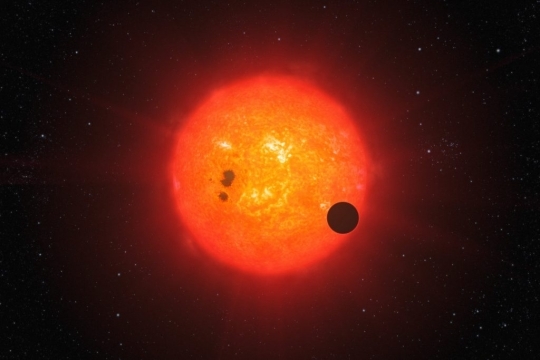
Image: Space mission data analysis is not easy, especially if you need to observe a planet passing in front of its star that is often 100s of lightyears away. At such distances, one of the main issues is differentiating what is planet and what is star. The Machine Learning ARIEL Data Challenge tackled the problem of identifying and correcting for the effects of spots on the star from the faint signals of the exoplanets’ atmospheres. This image shows a transiting planet passing in front of a star with stellar spots. Credit: ESO/L. Calçada.
ARIEL, which I mentioned last week, stands for Atmospheric Remote-sensing Infrared Exoplanet Large-survey. ESA is also launching what it calls the ‘ExoClock’ project to collect transit light curves. Here we turn to the community of amateur astronomers for assistance, for transits can be measured by small telescopes when properly equipped, and a growing number of amateurs have the needed hardware. The idea is to enlist a global community of observers to gather light curves that will be used by the ARIEL mission to improve the accuracy of transit timings, so the spacecraft will be armed with the best data on the exoplanets on its target list.
“This is the first open call to join the ExoClock project and we encourage all interested observers to become part of ESA’s ARIEL mission. Every transit observation is unique and important. By participating in ExoClock, citizens all over the world can contribute to the success of the ARIEL mission,” says Anastasia Kokori, who announced the launch of ExoClock at EPSC-DPS 2019.
Online resources are being set up to support the effort with a platform that includes an alert system to maximize the coverage of individual exoplanet targets and a system of target prioritization that allows individual users to have a personalized schedule based on their equipment and their geographical location. The light curves will be submitted and published along with analysis on the ExoClock website and may be included in scientific papers.
To learn more or to receive training in transit observations, go to the ExoWorlds Spies project (exoworldsspies.com). Experienced observers can register directly at exoclock.space. This citizen science opportunity is one that factors directly into the upcoming ARIEL mission, scheduled for a 2028 launch. Principal investigator Giovanna Tinetti comments on both the machine learning data challenge and the Exoclock effort:
“ARIEL is a challenging mission that’s pushing the boundaries of exoplanet research. The Data Challenges and ExoClock project are enabling us to build a global community of collaborators with a diverse mix of skills and backgrounds. We look forward to working with them over the next few years to develop networks, tools and analysis techniques in preparation for the mission’s launch in 2028.”
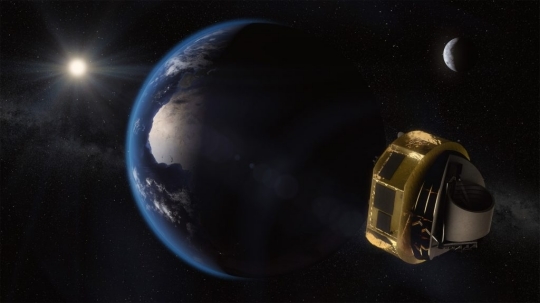
Image: Artist’s impression of ARIEL on its way to Lagrange Point 2 (L2). Here, the spacecraft is shielded from the Sun and has a clear view of the whole sky. Credit: ARIEL space mission/Science Office.
ARIEL will be the first mission dedicated to making a survey of the chemical composition and thermal structures of up to 1000 transiting exoplanets, bringing a new level of planetary science into the realm of other stars. The mission designers note that while we’ve discovered thousands of exoplanets, we have as yet no pattern that links their masses, sizes and orbital parameters to the nature of the parent star. How is a planet’s chemistry determined by its place of formation, and how does its evolution depend upon the properties of the star it orbits?
The mission will home in on warm and hot planets, ranging from super-Earths to hot Jupiters, to parse the chemistry of their atmospheres as they transit, making a deep survey of cloud systems as well as seasonal and even daily atmospheric variations for a subset of its targets. ARIEL will operate at visible and infrared wavelengths as it orbits the L2 Lagrange point 1.5 million kilometers behind the Earth as viewed from the Sun, with a mission duration of four years.
For more on ARIEL’s target list, see Edwards et al., “An Updated Study of Potential Targets for Ariel,” The Astronomical Journal Vol. 157, No. 6 (30 May 2019). Abstract / preprint.






September 16, 2019
Could We Send a Probe to C/2019 Q4 (Borisov)?
The arrival of an apparent interstellar visitor, the comet now designated C/2019 Q4 (Borisov), invariably calls to mind the all too swift passage of ‘Oumuamua through our skies in 2017. Detected 40 days after perihelion, the object was headed out of the Solar system when discovered, making observation time limited and the prospects of visiting it with a probe problematic. Nonetheless, Andreas Hein and colleagues at the Initiative for Interstellar Studies put out a mission concept we reviewed in these pages. To refresh your memory, see Project Lyra: Sending a Spacecraft to 1I/’Oumuamua (formerly A/2017 U1), the Interstellar Asteroid).
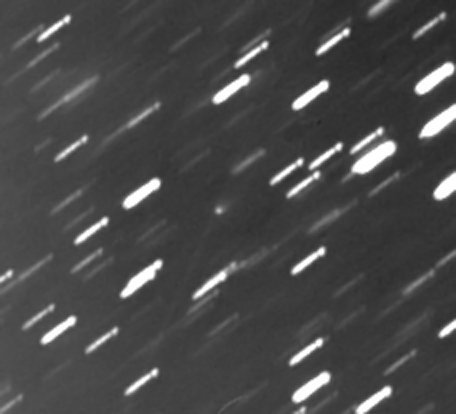
Image: C/2019 Q4 (Borisov), in the center of the image. Note what appears to be a short tail extending from the coma. Credit: Gennady Borisov.
The mission the authors described stretched the boundaries of the technologically possible, not to mention the resources that would be available for such an attempt. But now we have a second interstellar wanderer, one detected well before perihelion. In a new paper assembled in what must be record time, Hein and two i4IS colleagues, Adam Hibberd and Nikolaos Perakis tackle the challenge of reaching the comet, noting several options with varying launch dates.
This is interesting stuff, because as the paper notes, the fact that we have found both ‘Oumuamua and C/2019 Q4 (Borisov) so close together, plus the fact that better observing technologies are coming online to find such objects, indicates that the population of interstellar materials coming into the Solar system is high enough to generate new discoveries, and in the not so distant future at that. If any kind of mission concept can be developed that is remotely feasible for both interstellar visitors, we should soon find more we can reach with a probe.
Adam Hibberd’s role in the new paper was to develop the needed algorithms for calculating the trajectories involved. Called Optimum Interplanetary Trajectory Software (OITS), the software is used to calculate a direct transfer from Earth to C/2019 Q4 (Borisov) with flight durations of up to 10,000 days, with the necessary Delta-V (change in velocity) coming out below 100 kilometers per second, but still too high to obtain with existing chemical propulsion.
The software shows that a mission with feasible Delta-V and direct transfer from Earth would have had to have been launched in July of 2018, using a Falcon Heavy launch vehicle, with arrival at the object in October of 2019. We’re reminded again of the benefit of early detection of objects like these, capabilities that new facilities like the Large Synoptic Survey Telescope (LSST) should be able to deliver in just a few short years.
We learn, however, that other strategies can be deployed beyond chemical propulsion, and here we’re into various kinds of gravitational assists coupled with propulsive maneuvers. Key to the concept is the so-called Oberth maneuver, in which a spacecraft going deep into the gravitational well of a large object like the Sun accelerates at the point when it has reached maximum speed. Firing the engine when orbital velocity is highest gives the mission maximum kick and relies upon creating the highest thrust possible in the shortest period of time.
From the paper, describing the Oberth maneuver in the context of this mission:
For later launch dates, the DeltaV increases to levels where no existing chemical propulsion system would be able to deliver the required DeltaV. One possibility to still reach an interstellar object is to use an Oberth maneuver. For an Oberth maneuver, the spacecraft is injected into a trajectory with a [perihelion] close to the Sun, where the spacecraft applies a boost. The closer the boost is applied to the Sun, the larger the gain in DeltaV. Additional flyby maneuvers are used to bring the spacecraft on the initial heliocentric trajectory.
The authors envision using the Oberth maneuver at the Sun in combination with a Jupiter flyby, thus leveraging the deepest gravitational wells available to us in the Solar System. The proposed trajectory is shown in the figure below, drawn from the paper. Notice that the Jupiter flyby is here used to decelerate the spacecraft toward the Sun. The Oberth maneuver at the Sun then flings the spacecraft outbound for its encounter with C/2019 Q4 (Borisov).

Image: This is Figure 3 from the paper. The green line is the trajectory from the Earth to Jupiter, with the deceleration at Jupiter and subsequent trajectory toward the Sun shown as a blue line. The solid red line is the trajectory following the Oberth maneuver at perihelion. Credit: Hibberd, Perakis & Hein.
As to the mission components, the authors’ calculations show that C/2019 Q4 (Borisov) could be reached in 2045 following a launch in 2030, using the Space Launch System, the requisite heat-shield (this draws on existing work with the Parker Solar Probe), and solid-fuel propulsion engines. The payload is envisioned as a CubeSat-class spacecraft with a mass of 3 kg.
Thus we have the outline of a way of reaching our second interstellar object. It’s helpful to know how this could be done no matter how it stretches our current methods because if we do find many more such objects, some are bound to present fewer challenges than the first two, with mission concepts that may prove less demanding. It pays us to be thinking now about early detection and fast implementation of such designs as we add these interesting objects into our list of high-priority destinations. After Ultima Thule, perhaps a comet from another star?
The paper is Hibberd, Perakis & Hein, “Sending a Spacecraft to Interstellar Comet C/2019 Q4 (Borisov),” available now as a preprint.






September 12, 2019
C/2019 Q4 (Borisov): A Likely Interstellar Comet
What appears to be an interstellar comet is heading into the Solar System, with perihelion likely on December 10 of this year, a date that could change as orbital parameters continue to be firmed up. The natural comparison is with ‘Oumuamua, first discovered two years ago and now well on its way out of the system. But the object first labeled gb00234 and now carrying the provisional name C/2019 Q4 (Borisov), while clearly on a hyberbolic orbit, has been found before perihelion and should be visible for a much a longer period of observation and orbital calculation.
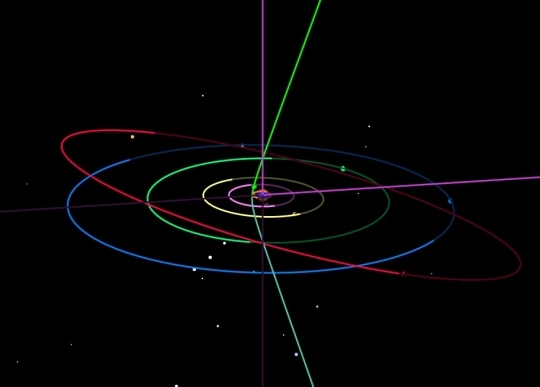
Image: Observations suggest that comet C/2019 Q4 (Borisov) may be from outside the Solar System. A hyperbolic solution for the object first labeled gb00234 passes between Mars and Jupiter. (Green=gb00234; Blue=Neptune). Credit: Tony873004 – Own work, CC BY-SA 4.0.
A professional optician and astronomer named Gennady Borisov at the Crimean Astrophysical Observatory (near the Crimean city of Bakhchysarai, on the Crimean peninsula) discovered the object on August 30, 2019 when it was at a distance of approximately 3 AU. This gentleman builds his own instruments, as physicist and radio astronomer Marshall Eubanks (VLBI) noted in a tweet this morning, replying to writer and journalist Corey Powell.
The telescope he used to discover C/2019 Q4 (Borisov) – an F/1.5 65 cm wide angle telescope he constructed in late 2018. pic.twitter.com/XK96af0x6X
— T. Marshall Eubanks (@TM_Eubanks) September 12, 2019
The Minor Planet Center (Smithsonian Astrophysical Observatory) now offers a Minor Planet Electronic Circular (MPEC) on C/2019 Q4 (Borisov) that notes the cometary nature of the object has been confirmed by ‘numerous observers.’ It also includes the news that the object will be visible for a good while. The appearance of the MPEC indicates sufficient data have been accumulated to make the call on the hyperbolic nature of the orbit.
Based on the available observations, the orbit solution for this object has converged to the hyperbolic elements shown below, which would indicate an interstellar origin. A number of other orbit computers have reached similar conclusions, initially D. Farnocchia (JPL), W. Gray, and D. Tholen (UoH). Further observations are clearly very desirable, as all currently-available observations have been obtained at small solar elongations and low elevations. Absent an unexpected fading or disintegration, this object should be observable for at least a year.
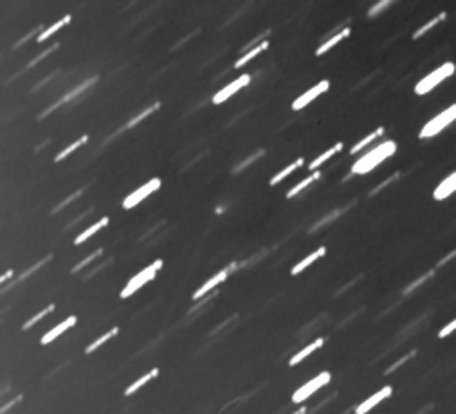
Image: C/2019 Q4 (Borisov), in the center of the image. Note what appears to be a short tail extending from the coma. Credit: Gennady Borisov.
What is striking here is the eccentricity, which at 3.08 (a figure worked out from 145 observations to this point) is clearly hyperbolic. Unlike ‘Oumuamua, we have a clear tail and a distinct coma, strengthening the object’s identification as a comet. Like ‘Oumuamua, its hyperbolic orbit is one that is unbound to the Sun, thus making this an interstellar object whose spectra will be examined with great interest. The object’s provisional designation will likely change, as did ‘Oumuamua’s, to something like object 2I/2019, making it the second in the category of interstellar objects, but clearly not the last as we tune up our methods.
Here's a remarkable animation of #gb00234, which may be our second known interstellar visitor, taken by astronomer Gennady Borisov – who discovered the object.
2l/Borisov, perhaps?
(source: https://t.co/vkYXrK6KBC) pic.twitter.com/WObsGj3HJH
— Jonathan O’Callaghan (@Astro_Jonny) September 11, 2019
Based on the orbital solutions now in play, C/2019 Q4 (Borisov) should close to within about 1.8 AU of the Sun before beginning its exit from the Solar System, allowing observatories all over the world to study it. While ‘Oumuamua presented puzzles that are still being resolved, the cometary nature of this object is becoming established and we will have plenty of time to study it. Remember, too, that the Large Synoptic Survey Telescope (LSST) team anticipates first light in 2020. Its planned surveys are likely to turn up interstellar objects in large numbers.
Particular thanks to Jean Schneider (Observatoire de Paris) for early thoughts on C/2019 Q4 (Borisov), as well as numerous readers who checked in via email.






September 11, 2019
Water Vapor Detection on a ‘Super-Earth’
We’re beginning to probe the atmospheres of planets other than gas giants, a step forward that the next generation of space- and ground-based instruments will only accelerate. This morning we have word that the habitable zone ‘super-Earth’ eight times as massive as Earth orbiting the star K2-18 has been found to have water vapor in its atmosphere, making it the only exoplanet known to have water as well as temperatures that could sustain that water as a liquid on the surface. This is also our first atmospheric detection of any kind for a planet orbiting in the habitable zone of its star.

Angelos Tsiaras (University College London Centre for Space Exochemistry Data) is lead author on this work, which appears today in Nature Astronomy:
“Finding water in a potentially habitable world other than Earth is incredibly exciting. K2-18b is not ‘Earth 2.0’ as it is significantly heavier and has a different atmospheric composition. However, it brings us closer to answering the fundamental question: Is the Earth unique?”
Image: UCL’s Angelos Tsiaras. Credit: University College London.
If Dr. Tsiaras’ name seems familiar, it’s because you’re recalling his work on the super-Earth 55 Cancri e, reported in these pages back in 2016 [see Light, Dry Atmosphere of a ‘Super-Earth’]. Tsiaras and team used a methodology they developed to detect significant amounts of hydrogen and helium in this world, working with transmission spectroscopy data from the Hubble telescope. Now, collaborating with UCL colleagues, Tsiaras again uses Hubble, to analyze starlight filtering through the atmosphere of K2-18b as it crosses the face of the star as seen from Earth.
The molecular signature of water vapor is clear, as is the evidence for both hydrogen and helium, while such molecules as nitrogen and methane, if present, are undetectable at these levels. It will be fascinating to see whether we can move on from these observations to estimate the planet’s cloud cover and percentage of atmospheric water. The star is a cool red dwarf 110 light years away in the constellation Leo. And it presages the kind of work that the study of such nearby stars will generate, as co-author Ingo Waldmann (UCL) notes:
“With so many new super-Earths expected to be found over the next couple of decades, it is likely that this is the first discovery of many potentially habitable planets. This is not only because super-Earths like K2-18b are the most common planets in our Galaxy, but also because red dwarfs — stars smaller than our Sun — are the most common stars.”
Thus we move on to the next generation, which includes the James Webb Space Telescope as well as the interesting ARIEL (Atmospheric Remote-sensing Infrared Exoplanet Large-survey), slated for a 2028 launch by the European Space Agency. ARIEL’s charter will be to observe at least 1,000 known transiting exoplanets, going to work on their atmospheric composition, chemistry and thermal properties. K2-18b will obviously be one of its targets as we dig further into conditions on its surface. Meanwhile, we can expect TESS (the Transiting Exoplanet Survey Satellite) to detect hundreds more super-Earths as it continues its mission. No shortage of targets!
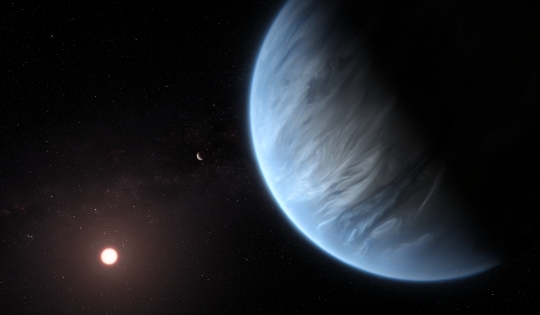
Image: Exoplanet K2-18b. This artist’s impression shows the planet K2-18b, its host star and an accompanying planet in this system. K2-18b is now the only super-Earth exoplanet known to host both water and temperatures that could support life. UCL researchers used archive data from 2016 and 2017 captured by the NASA/ESA Hubble Space Telescope and developed open-source algorithms to analyse the starlight filtered through K2-18b’s atmosphere. The results revealed the molecular signature of water vapour, also indicating the presence of hydrogen and helium in the planet’s atmosphere. Credit: ESA/Hubble, M. Kornmesser.
K2-18b was detected in 2015 through light curve analysis made possible by Kepler in its reconfigured K2 phase, its mass later constrained by radial velocity data from HARPS, leaving researchers to believe it is either a large, rocky planet or a water planet with an ice crust. The latter work, led by Ryan Cloutier (University of Toronto), also discovered a second, non-transiting super-Earth in the system, moving on an orbit interior to K2-18b.
The paper is Tsiaras et al., “Water Vapour in the Atmosphere of the Habitable-Zone Eight Earth-Mass Planet K2-18 b,” Nature Astronomy 11 September 2019 (abstract). Also see Benneke et al, ”Water vapor on the habitable-zone exoplanet K2-18b,” submitted to Astronomical Journal (preprint). Björn Benneke (Université de Montréal) is a co-author on the Tsiaras paper. [My mistake, looking at the wrong abstract].
The Cloutier paper referenced above is “Characterization of the K2-18 multi-planetary system with HARPS: A habitable zone super-Earth and discovery of a second, warm super-Earth on a non-coplanar orbit,” Astronomy & Astrophysics Vol. 608, A35 (5 December 2017). Abstract.






September 10, 2019
A New Explanation for Lakes on Titan
The vast amount of data returned to Earth from the Cassini mission continues to pay off with new research angles, a process that will continue for years to come. Today we learn of a possible explanation for an odd feature of some methane-filled lakes on Saturn’s moon Titan. As viewed in Cassini radar data, we can see what appear to be sharp ridges, along with cratered edges, raised rims and ramparts. Interestingly, some of the steeper ridges are considerably higher than Titan’s liquid sea level. Winnipeg Lacus, a small lake near Titan’s north pole, is but one example.
The model currently in play about Titan’s lakes is that liquid methane dissolved a bedrock of ice and solid organic compounds — essentially creating the reservoirs which it then fills. The process is similar to karstic lakes found on Earth as the result of bodies of water dissolving surrounding limestone, dolomite or gypsum, with distinctive sinkholes and caves.
But an international team of researchers headed by Giuseppe Mitri of Italy’s d’Annunzio University now offers an alternative. In this scenario, changes in temperature over the aeons on Titan could cause pockets of liquid nitrogen below the surface to become a pressurized, explosive gas, blowing out the craters which later warming events would fill with methane.
This process accounts for features that the karstic lake basin theory fails to address. Jonathan Lunine (Cornell University) is a co-author of the paper on this work:
“You either need gas that ignites explosively or a gas that builds up enough pressure so that it just pops like a cork from a champagne bottle. On Titan, there is nothing that will create a fiery explosion because that moon has no free oxygen,” says Lunine. “Thus, a pressurized explosion model, we argue, is a better model for those kinds of lakes. Craters are created and they fill with liquid methane.”
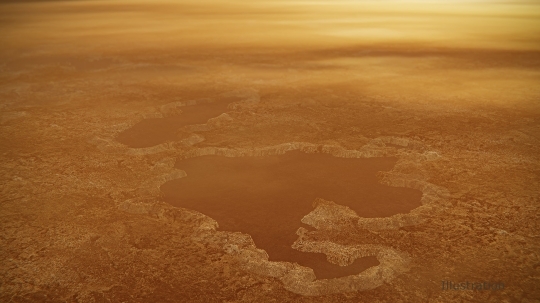
Image: This artist’s concept of a lake at the north pole of Saturn’s moon Titan illustrates raised rims and rampart-like features such as those seen by NASA’s Cassini spacecraft around the moon’s Winnipeg Lacus. New research using Cassini radar data and modeling proposes that lake basins like these are likely explosion craters, which could have formed when liquid molecular nitrogen deposits within the crust warmed and quickly turned to vapor, blowing holes in the moon’s crust. This would have happened during a warming event (or events) that occurred in a colder, nitrogen-dominated period in Titan’s past. The new research may provide evidence of these cold periods in Titan’s past, followed by a relative warming to conditions like those of today. Although Titan is frigid compared to Earth, methane in the atmosphere provides a greenhouse effect that warms the moon’s surface. Credit: NASA/JPL-Caltech.
To make the effect work, we have to consider the interplay between nitrogen and methane, for the geophysical history of Titan, the researchers believe, includes eras when methane is depleted, with nitrogen as the primary constituent of a much colder atmosphere. Cooling nitrogen would produce liquid rain which could collect in pockets beneath the moon’s crust. The catalyst for explosion could well be geologic heating. The craters thus produced would later be filled with methane. Lunine likens the process to what Voyager II saw at Neptune’s large moon Triton.
“We saw these big deposits of nitrogen with streaks of black that looked like cigarette burns on the nitrogen ice. It was dust under the nitrogen being heated by the sun, allowing the nitrogen to explode outward.”
Are we then, seeing a Titan today that is in a much warmer phase than the frigid moon of earlier times in its evolution? Methane has acted as a greenhouse gas on this moon for perhaps as long as a billion years, but the model advocated here is that Titan has gone through cycles of heating and cooling, with methane first depleted and then resupplied. Thus steep edges and raised rims would speak to an epoch when liquid nitrogen was plentiful on the surface.
The key question, then, is how far we can take this hypothesis of climate change on Titan. Here is a snip from the paper addressing the matter:
The photochemical lifetime of methane in Titan’s atmosphere is several tens of million years, and the value of 12C/13C in Titan’s atmosphere indicates that the current atmospheric inventory of methane probably outgassed ~107–108 yr ago. Evolution models suggest that Titan’s crust is composed of water ice and clathrate hydrate, with mostly methane as primary guest species, and that episodic methane outgassing could be a cause for the continued presence of methane in the atmosphere. However, in the absence of continuous or frequent outgassing from the crust or deeper methane sources, Titan’s atmosphere in the past may have been episodically methane depleted [italics mine]. Under such conditions, the greenhouse effect would have been limited to the collision-induced absorption of N2–N2, resulting in a Titan that was colder than at present, with a mean surface temperature lower than 81 K…
The supposition that infrequent methane outgassing events would have allowed intervals between them when the surface was pocked with liquid nitrogen lakes, along with crustal aquifers of nitrogen in the polar regions, is thus key. We would, then, wind up with a stable nitrogen cycle at lower temperatures that parallels the methane cycle we see on Titan today. Small temperature variations could then produce the explosions presumed to create the lake beds that show up in Cassini’s data.
The authors make the case that if the lakes we see today are the result of explosive eruptions, then this itself is evidence of a cold nitrogen-dominated epoch followed by subsequent rewarming. A 2 K increase in Titan’s temperature between 1989 and 1998 along with an increase in atmospheric pressure may have been the result of rising nitrogen levels:
On Triton, the venting of nitrogen and possibly methane and an increase of atmospheric pressure are probably due to warming events that may mirror processes that happened in Titan’s nitrogen-dominated past.
The paper is Mitri et al., “Possible explosion crater origin of small lake basins with raised rims on Titan,” Nature Geoscience 9 September 2019 (abstract).






Paul Gilster's Blog
- Paul Gilster's profile
- 7 followers



